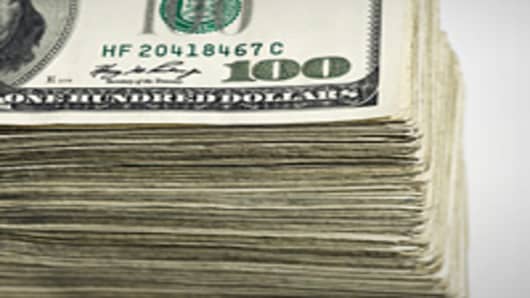February is the busiest month for dividend declarations and increases, and this year, the biggest U.S. corporations may pay out a record amount, making up for some of the cash they withheld from shareholders during the financial crisis and earlier stages of the recovery.
The dividend rate, or the payout rate of the S&P 500 companies, hit an all-time high in June 2008, but it fell sharply by August 2009.
It is now up 31.8 percent since then, but still lags the 2008 level by about 2.5 percent, according to Standard and Poor’s data.
For all of last year, S&P 500 companies paid out a total $241 billion, versus the $247.9 billion they gave shareholders in 2008. The payout rate fell to a trough of $196 billion in 2009, as companies increasingly hoarded record amounts of cash.
“I expect the index will retake that high later this year and hit a new record,” notes Howard Silverblatt, senior index analyst for Standard and Poor’s indexes. “I’m looking for $263 billion by the time this year is over.”
Bespoke Investment Group co-founder Paul Hickey said already this year, there seems to be an increase in dividend raises already.
“Compared to the last three years, I think we’re going to see much more in the way of dividend raises. There’s more clarity out there. There’s a general view that the worst is behind us. Most people would think that companies have a little bit more visibility now. With increased visibility, they’ll be more likely to part with some of their cash,” said Hickey.
Financials were responsible for more than 31 percent of the S&P 500 payouts in 2007, and they provided just 11.8 percent of the payout in 2011.
Consumer staples in 2011 were the biggest contributor, providing 15.5 percent of the total S&P 500 payout, while technology, seen as an underachiever when it comes to dividends, provided a surprising 10.4 percent of the total last year, according to Silverblatt.
Part of that is because Cisco , which had the biggest dividend initiation ever last March at $1.5 billion. It raised that dividend this week to eight cents per share on a quarterly basis, from six cents per share.
“Dividend reductions are event driven, but increases by companies that increase every year, or every couple of years, traditionally go at the beginning of the year,” said Silverblatt.
The S&P 500 is currently yielding 2.09 percent but if stocks are removed that don’t pay dividends, the average yield of the remaining 396 issues averages 2.46 percent, says Silverblatt. He said the historic yield, going back to the 1930s, is 3.76 percent and the average for the last decade was 1.9 percent.
“From 1962 to currently, the S&P dividend yield dividend by the 10-year yield was 43 percent, less than half,” Silverblatt said. Now with the 10-year yielding less than 2 percent, the yield is 7 percent higher, he notes.
So far this year, 63 companies in the S&P 500 have announced dividend actions, with 61 increasing their payout rate and two companies initiating dividends, according to Standard and Poor’s.
Hickey says stocks that have built a reputation for consistently paying dividends are a relatively safe place to look for yield. Bespoke screened the S&P 500, looking for companies that have consistently raised dividends, for at least 10 years. They also looked for companies that yield more than 2.5 percent and are paying out less than half of estimated earnings for the current year.
“While they aren’t necessarily glamorous names, they are companies that have managed to raise their dividends even during one of the worst economic calamities in more than a generation. Investors who are on the sidelines looking to gain equity exposure, are probably unlikely to go right into high growth names, so these stocks provide a good area of the pool to dip their foot in,” notes Hickey, who did the screen.
“What I would say about these stocks is if you have 20 percent year in the market, they’re probably going to underperform the market, but if you have a down year, they’re going to outperform. They’re almost like fixed income equities,” he said. “…Also they were able to raise dividends through 2007, 2008, 2009. They were able to navigate through those years. They are pretty solid companies.”
The companies Hickey found that met his criteria are listed below. He said utilities have the best reputation as dividend raisers, but what he in fact found was that the consistent payers came from a diverse group of industries.
Bespoke’s List:
- Conoco Phillips — Yield: 3.65
- NextEra Energy — Yield: 3.64
- Johnson and Johnson — Yield: 3.49
- Abbott Health — Yield: 3.46
- Bemis — Yield: 3.18
- Northeast Utilities — Yield: 3.09
- Pepsico — Yield: 3.09
- Emerson Electric — Yield: 3.07
- Chevron — Yield: 3.03
- Linear Technology — Yield: 2.92
- McDonald’s — Yield: 2.80
- Coca Cola — Yield: 2.75
- MMM — Yield: 2.68
- Aflac — Yield: 2.67
- General Dynamics — Yield: 2.63
- Norfolk Southern — Yield: 2.59
- Illinois Tool Works — Yield: 2.57
- Air Products — Yield: 2.56
- ACE Ltd — Yield: 2.55
- Colgate Palmolive — Yield: 2.54
Questions? Comments? Email us at marketinsider@cnbc.com



